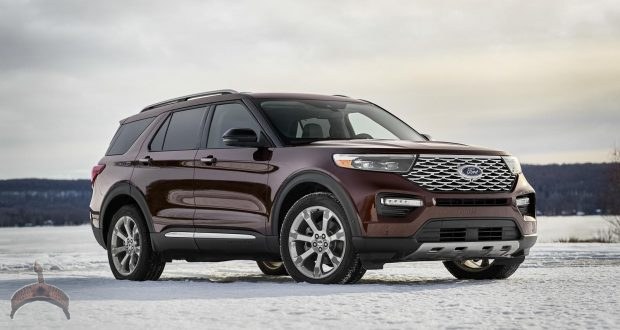The Ford Explorer has been around for almost 30 years. During this time, the SUV segment has developed in a way no one could dream of. The Explorer is still a mainstay of the segment on which the SUV world has stood for almost three decades. It started off with a bang and established itself as one of the most popular SUVs in the market. This success took more than a decade before the Explorer got lost when other SUVs arrived. The sales finally crashed and Ford desperately wanted
to recapture the magic the Explorer had when it became a breakout hit in the early ’90s.
First Generation: (1990 – 1994)

The Explorer was originally a modest off-road vehicle built on the Ford Ranger chassis.
It also shared a number of parts with the Ranger, especially the panels in front of the A-pillar and the dashboard. The first generation Explorer was also just 174.5 inches long, which is nowhere near the size of the current explorer, which spans nearly 200 inches. In terms of design, Ford used the box-shaped design of the time and gave the first-generation Explorer a simple three-blade grille and a pair of rectangular red headlights. A flat side glass, built-in mirrors and lack of drip rails were also some of the most outstanding design details of the first-generation Explorer. Ford also offered the model as a two-door and four-door model, allowing customers to choose the model that best suits their needs.
Under its hood, Ford built a 4.0-liter V6 engine that produced 155 hp and 220 lb-ft of torque. Later model years received a five-horsepower shock, although the torque figures remained the same.
Second Generation (1995 – 2001)
In spite of its growing popularity, the first-generation Ford Explorer has only lasted four years on the market. Perhaps Ford wanted to capitalize on the success of the SUV and in 1995 launched the second-generation Explorer with a new look and enhanced off-road capabilities.

One of the automaker’s most significant changes was to replace the i-Beam front axle with a new, independent wishbone setup, with the rear axle still under tension. In terms of design, round headlights and an equally round radiator grille have been changed. However, the biggest change was the size. The five-door Explorer of the second generation grew to 190.7 inches, a by-product of Ford trying to fill the space the Bronco had a year before the arrival of the second-generation Explorer.
The second-generation model was also the first Explorer with a variety of engine options. The same 155-horsepower 4.0-liter V-6 remained in the crease, but Ford also added a 5.0-liter V-8 that produced 210 horsepower and 280 lb of torque, which eventually set in later years 215 hp increased. A third engine – a 4.0-liter V-6 – was also included in the model range. This engine produced 205 horsepower and 250 pound-foot of torque.
Third Generation (2002 – 2005)

The third-generation Ford Explorer has undergone the most dramatic changes so far.
Sure, it was still a body SUV, but the decision to create a unique platform was triggered by the automaker’s plan to turn the Explorer into a more family-oriented SUV and compare it to mainstream crossovers like the Volkswagen Tiguan.
Part of this plan was the introduction of seats in the third row, which was a first for the Explorer. Ford was able to accommodate this by adding a new rear independent rear suspension that freed up space for the aforementioned third row, giving the SUV improved ride quality over its predecessor.
For this generation, Ford offered the 4.0-liter V-6 with 210 hp and 255 pound-foot torque as the base engine. To give customers a little more, Ford brought a more powerful 4.6-liter V-8 full aluminum hat with 240 hp and 280 pounds of torque in the mix. By combining the new V-8 unit with the bodywork design of the SUV, the third generation Explorer was able to haul up to 7,300 pounds and fully establish itself as a more domesticated SUV. Aesthetically, the Explorer of the third generation returned to its roots in rectangular headlights, although the front grille of the SUV of the formal language of Ford at that time corresponded.
Fourth Generation (2006 – 2010)

Just like the first-generation Ford Explorer, the third-generation model only lasted four years before Ford introduced the fourth-generation model. We can speculate on the reasons, but it’s no coincidence that both generations ended because Ford wanted to quickly introduce a new one. The reasons were different, but the idea was the same.
The fourth-generation Explorer hit the market in 2006, continuing its transition from a rugged SUV to a mainstream crossover.
The fourth-generation Explorer also arrived with a more powerful 4.6-liter V-8 that produced 292 horsepower and 300 pound-foot of torque. All this power flowed over a new six-speed automatic transmission. Those who did not want the V-8 Explorer could still take the base unit, the previous-generation 4.0-liter V-6 engine, with the same power of 210 horsepower and 255 pounds of torque. The base unit also had the same five-speed automatic transmission that was adopted by the previous generation.
Fifth Generation (2011 – 2019)

The fifth-generation Explorer was the most dramatic generation change we saw in the SUV. We can talk about the aesthetics and overall presentation of the fifth-generation Explorer as important reasons for its return to form, but undoubtedly the most important change Ford has made is to disassociate the Explorer from body-on-frame construction It underpinned since its founding in 1990, the uni-body construction. This decision ultimately gave the explorer the family-friendly, car-based crossover credentials it had missed since Ford decided to change his identity. It also helped that Ford gave the fifth generation a contemporary design. The Explorer did not look like it used to – it actually looked like a real Auto-basis crossover, the same SUV guy that was the latest craze.
Under its hood, the fifth-generation Explorer hides new engine options that not only deliver more power, but also dramatically reduce fuel consumption. The base unit used a 3.5-liter V6 engine that produced 290 hp and 255 lb-ft of torque and was combined with a six-speed automatic transmission. Together with the new car-based design, these numbers helped the SUV in the city to a top speed of 17 MPG and on the highway to a top speed of 23 MPG for four-wheel drive models. The front-wheel drive versions performed even better, returning 18 mpg in the city and 25 mpg on the highway.
The fifth-generation Explorer also received a 2.0-liter turbo engine with a horsepower output of 237 hp and 250-pound-foot torque.
That had better EPA returns at 20 mpg in the city and 27 mpg on the highway. Eventually, this engine developed into a 2.3-liter turbocharged four-pot, producing 280 horsepower and 310 lb-ft of torque.
Sixth Generation (2020 – )

Take a step back and consider how far the Ford Explorer has come after its first appearance in the automotive scene in 1990. It has reached the highest and lowest levels. It has prospered and it has faltered. The sixth-generation Explorer presents itself in a completely new design that takes its place in the current SUV hierarchy.
It has a defined aperture and a larger and more distinctive grille than its predecessor. It also has unique lighting elements on the back, a product of the new technology in this room. The new Explorer is also available with two engine options: a 2.3-liter turbocharged four-cylinder engine that delivers 300 horsepower, and an optional dual-turbocharged V-6 that pumps out 365 horsepower. Hybrid power is also expected, and even four- and six-cylinder engines are no fun. Among them is Ford’s new CD6 platform, which offers the SUV both rear-wheel drive and four-wheel drive options. The latter will be an option.
Source: Topspeed
 Ọmọ Oòduà Naija Gist | News From Nigeria | Entertainment gist Nigeria|Networking|News.. Visit for Nigeria breaking news , Nigerian Movies , Naija music , Jobs In Nigeria , Naija News , Nollywood, Gist and more
Ọmọ Oòduà Naija Gist | News From Nigeria | Entertainment gist Nigeria|Networking|News.. Visit for Nigeria breaking news , Nigerian Movies , Naija music , Jobs In Nigeria , Naija News , Nollywood, Gist and more








